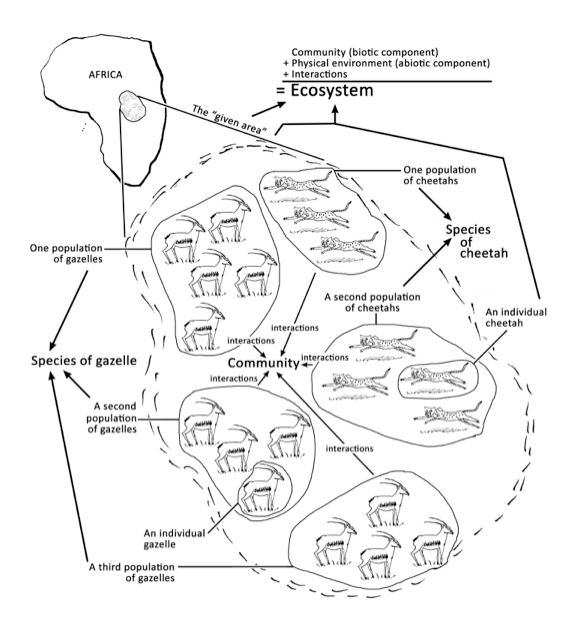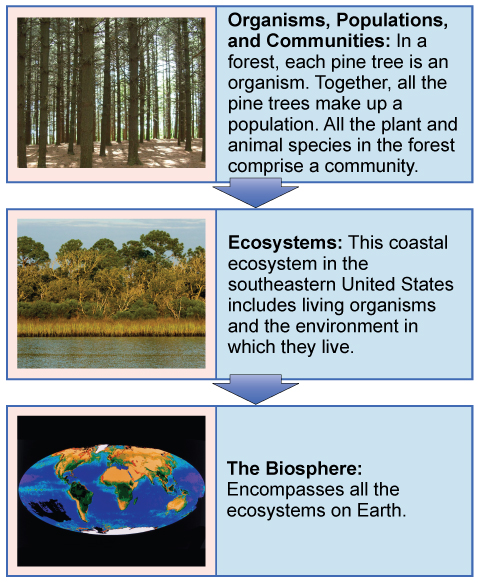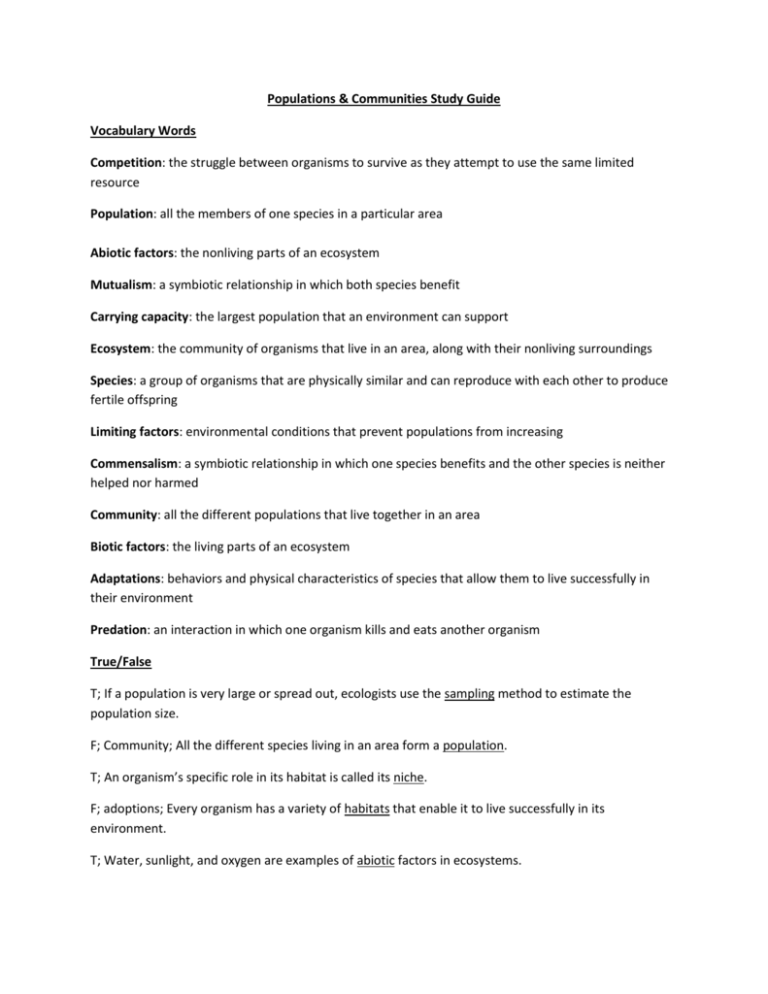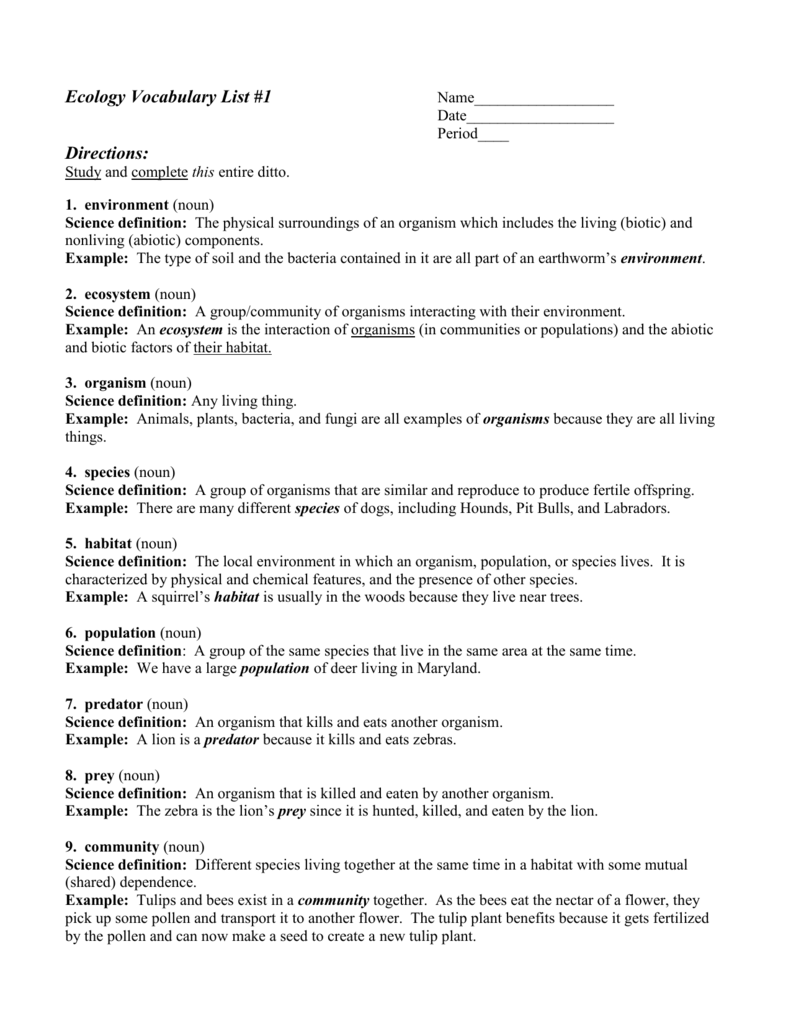Describe a Community Using the Vocabulary Words Species and Population
A species that is not known historically in an area. It consists of all of the populations that share the same environment.

Organism Population Community Ecosystem Biosphere Ecosystems Biology Classroom Science Biology
Have the students read about the history of human ancestors.

. Species includes all the organisms that are genetically similar. Community change that occurs with land already formed. Species is the first level of an ecosystem followed by population and then by the community.
- There is now no gene flow between the two populations. When looking at the fossils scientists look for clues to changes in different characteristics such as brain size skull shape locomotion and jaw size. A population refers to a group of interbreeding individuals of the same species isolated from other groups while a community refers to a group or association of populations of two or more different species occupying the same geographical area and in a particular time.
- a measure of how close together people live in an area. Up to 24 cash back A group of individuals that interbreed and produce fertile offspring Members of a species that live in the same area at the same time All the populations in a particular area All the living things and their physical environments within a particular area I can think about the meaning of the word ecosystemby thinking of ecologyand system. - a person who leaves one country with the intention of settling in another.
A population whose members can breed and produce fertile offspring. A form of reproductive isolation in which two populations are separated by geographic barriers such as rivers mountains or bodies of water. Population and Community The terms Population and Community are used in ecology to describe a group of different species inhabiting the same geographical space at a particular time.
Species A group of organisms that are physically similar and can mate with each other and produce offspring that can also mate and reproduce. Hence this is the main difference between population and community. A population contains genetic variations among themselves.
This refers to all the populations in a particular area at a given time. Heterogeneity is a term that refers to the variety of either an environment or population. A population consists of all the genes of a particular species which means the gene pool is represented in the entity of population.
- A community consists of all of the living things that inhabit a particular area. - A Mountain community could consist of river otters trout mayflies mountain laurel cardinals and flowering dogwood. A interspecific competition b intraspecific competition c predation d territoriality e symbiosis.
View 6_Population_and_Community_Ecology_RGpdf from BIOLOGY 1401 at Harlingen H S - South. For example a heterogeneous natural area is composed of numerous different habitat patches that differ from one another in various ways. Place the vocabulary cards on the board.
A single living thing that can breedproduce fertile offspring. This no-prep Vocabulary Activity involves researching prefixes suffixes and root words associated with the following vocabulary of Populations Communities and Ecosystems. Adaptation natural selection niche interaction competition predation population eutrophication ocean acidification volcanic eruption symbiosis mutualism commensalism parasitism.
Different interacting populations that live together in. The number of live births for every 1000 of the population. Cane toads in Australia Species diversity.
The structure involves different types of interactions among. Cut down of genetic diversity due to loss of individuals in a population. - the number of deaths for every 1000 of the population.
See immature community mature community. Describe each of the following species interactions and give an example of each. Alternatively a heterogeneous population has high levels of genetic variation.
Community According to the definition community is the ecological unit that is composed of a group of organisms in different populations of different species that occupy a particular place at a particular period while. The major difference between these terms is their level in the ecosystem. Noun a group of organisms of the same species inhabiting a given area they hired hunters to keep down the deer population see more noun the number of inhabitants either the total number or the number of a particular race or class in a given place country or city etc.
Explain to the students that the words community and population have multiple meanings and that in science they mean something else. Colony of a species of penguins living on a piece of land community. Community All of the different.
The different kinds of organisms found on earth constitute the species. Community Ecological Different populations of organisms interacting in a shared environment. Grocery store fire station people and so forth.
- an area that is crowded with people. Community is the term that denotes all the other organisms living in a place irrespective of their species. Up to 24 cash back ecological succession.
A count of how many species are in an area. This turtle here population. - A community is an assemblage of populations.
Population Group of individual organisms of the same species living in a particular area. Individuals of the species that live in the same area. Ask the students to describe the population.
It comprises all the organisms of a given species in a particular region at a particular time. Loren Averyt Chapter 6. Vocabulary Words Species diversity Mutualism Habitat islands Pioneer species Mimicry Lichens Coevolution Biotic potential.
The separation of a species or population so that members can no longer interbreed. Competition When individuals or groups of organisms compete for similar resources such as territory mates water and food in the same environment. Population and Community Ecology Reading Guide Vocabulary.
Students may share that the population refers to people. The nature around us exists at several levels of complexity Inkelas Bowie Guirguis 2017. See ecological succession pioneer community.
Scientists who study early humans depend on fossil evidence to help them sort out how our ancestors evolved over time. Pioneer species First hardy speciesoften microbes mosses and lichensthat begin colonizing a site as the first stage of ecological succession. Population All the members of one species in a particular area.
Answer - generic example all the key words - A population of species shows a great deal of variation - If a population splits divides into two or more populations by means of a physical barrier.

Ecology Characteristics Of A Healthy Mature Ecosystem Relationships Ppt Video Online Download

Population Ecology Definition Examples Expii

Ecosystems Task Cards Distance Learning Compatible Task Cards Science Interactive Science Notebook

Introduction To Ecology Review Article Khan Academy

Ecosystem Ecology Digital Activity Video Video In 2021 Middle School Science Activities Upper Elementary Science Middle School Science Classroom

98unit 7 Vocabulary Species Population Community Ecosystem 97 11 19 2014 Starter Unit 7 Vocabulary Application 1 Work With Your Table Partners To Ppt Download

Levels Of Ecology Foldable Understanding Ecological Levels Ecology Lessons Ecology Interactive Notebook Vocabulary Words

Populations Communities Study Guide

Ecology Levels Principles Organizations In Ecology Pmf Ias Ecology Ecosystems Unit Ecosystems

Ecology Characteristics Of A Healthy Mature Ecosystem Relationships Ppt Video Online Download

Population Ecology Definition Examples Expii

Population Community Ecosystem Biosphere Ecosystems Ecology Teaching Ecology

Ecological Levels From Individuals To Ecosystems Article Khan Academy

Ecosystems Guided Practice Print Google Versions Teaching Close Reading Guided Practice Middle School Science Resources

Ecology Vocabulary Matching Sort W 46 Terms Definitions Real World Examples Vocabulary Social Studies Worksheets Vocabulary Activities




Comments
Post a Comment